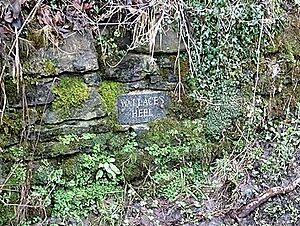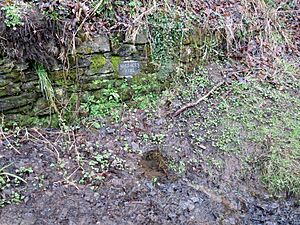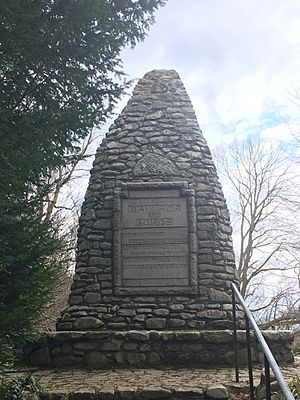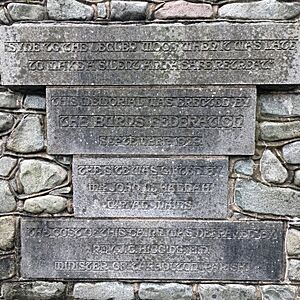Wallace's Heel Well facts for kids
Wallace's Heel Well, also known as Wallace's Heel, is a cool spot next to the River Ayr in Scotland. It's a special rock that looks like a heel print. People say it's where the famous Scottish hero, William Wallace, left his mark while escaping from English soldiers a long, long time ago.
Contents
What is Wallace's Heel Well?
This unique well or spring is right on the river bank. You can reach it by steps, which have been there since the Victorian era. A spring of fresh water flows out of a rock that looks like a heel. There's a stone wall nearby with a plaque that says "Wallace's Heel."
Years ago, people could even find a brass ladle (a type of spoon) attached by a chain to drink from the well! Old postcards from the 1940s show that the area used to have pretty garden flowers. Sometimes, when the river gets very full, the well can be covered by water. Close by, you can also see an old lime kiln, which is a building used to make lime.
The Story of William Wallace's Escape
The legend of Wallace's Heel Well is an exciting tale about William Wallace. One day, in a place called Riccarton, Wallace, who was unarmed, bravely fought off several English soldiers by himself. Because of this, he had to hide. He chose Leglen Wood, a secret forest near Auchencruive.
However, Wallace often visited the town of Ayr. On one trip, he saw some English soldiers challenging anyone to a strength contest. If you could hit one of them hard enough with a staff, you'd win a "groat," which was a good amount of money back then. Wallace took the challenge and hit the soldier so hard that he broke his spine! The other soldiers were furious and tried to catch him.
Wallace immediately ran towards Leglen Wood. He followed a path along the River Ayr. Soon, he realized the English soldiers were using dogs to track him, and they were getting very close. When he reached a spot called Holmston, he jumped down onto the rocks by the river. It's said that when he landed, his heel left an imprint in the rock, and a spring of water immediately began to flow from it!
After that, Wallace quickly jumped into the river and swam to the other side, where his horse was waiting. He made it safely back to the hidden Leglen Wood. People say that Wallace's Heel Well has been flowing ever since that day.
What are Petrosomatoglyphs?
Wallace's Heel is a great example of something called a petrosomatoglyph. This is a fancy word for a supposed image of a human or animal body part found in rock. These marks are found all over the world. They often have special meanings and were used in important ceremonies, like crowning kings. Some people believe they are marks left by saints or famous heroes.
Footprints are the most common type of petrosomatoglyph. For example, there are heel prints on a stone at Stonehenge. But you can also find other body parts like elbows, knees, heads, hands, or even animal prints like horse hooves or dog paws carved into rocks.
Other Local History
Not far from Wallace's Heel Well, on the other side of the river, there was once a place called Wallace's Cave. People say that William Wallace also used this cave to hide from English troops.
There's also a special monument, called a cairn, dedicated to William Wallace and another famous Scottish poet, Robert Burns. It's located in a small part of Leglen Wood. This cairn was built in September 1929 by a group called The Burns Federation. It's a place to remember both heroes.
The words carved on the cairn say:
WALLACE AND BURNS
FOREVER, NEVER, SCOTIAS REALM DESSERT
BUT STILL THE PATRIOT AND THE PATRIOT BARD
IN BRIGHT SUCCESSION RAISE HER ORNAMENT AND GUARD.'
SYNE TO THE LEGLEN WOOD WHEN IT WAS LATE
TO MAKE A SILENT AND A SAFE RETREAT.'







